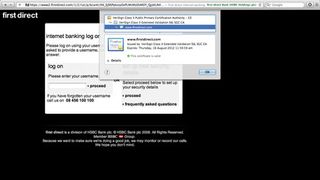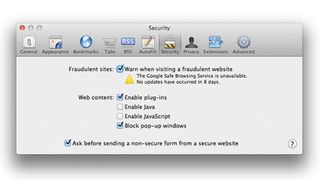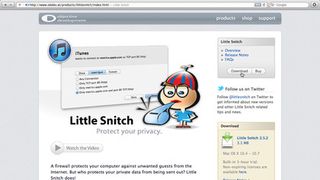How to protect your Mac against viruses
Are we wrong not to worry too much about cyber-attacks targeting Macs?
I've got the remedy

Despite the fact that Macs obviously aren't invulnerable, there isn't a real and pressing need to install anti-virus and anti-malware protection as a matter of course. However, such programs are available if you feel the need for additional security. Just remember that those programs' databases need to be updated regularly otherwise you won't be protected from the latest malware, just the ones the developers knew about when they released the version you purchased.
You can get Norton AntiVirus 12 for Mac, Intego VirusBarrier X6 or Bitdefender Antivirus for Mac, to name but three. If you're on a budget and are looking for free alternatives, Bitdefender Virus Scanner and ClamXav, among others, are available directly from the Mac App Store.
But malware isn't your only source of concern: you need to be wary of scams cleverly designed to part you from your money or personal information. This is called phishing. I'm sure we're all wise to those emails from rich deposed Nigerians who need to hide their funds in your bank account for just a few days, but most modern scams are cleverer than that.
You may find an email appear in your inbox from your bank, asking you to log into your account because someone may have gained access to your funds. If you were to follow the instructions and click on the link provided, you'd be sent to a page that looks so much like your bank's that you could be fooled into handing them your username and password, and after that… well, let's not think about the consequences.
What's the password?
So how can you avoid falling prey to such scams? Your bank or other institution would never contact you in this way for such information, but simply ignoring those emails isn't enough.
Most of us only use a handful of passwords for our internet activity (some only use one), so if 'YouTube' contacts you and asks for your password and you give it to them, those scam artists have your email address and password, and can try them on other sites, such as eBay or Amazon, and go on a shopping spree.
Many of these scam websites are known, and modern browsers will warn you if you're heading into dangerous territory, but this is a game of cat and mouse with websites often moving around faster than anyone can keep track of, which is why you need to apply a little diligence.
Get daily insight, inspiration and deals in your inbox
Get the hottest deals available in your inbox plus news, reviews, opinion, analysis and more from the TechRadar team.
Your Mac is there to help you with that. For instance, if you see a link in a potentially dodgy email, move the cursor over it but do not click on it. After a few seconds, a yellow pop-up appear showing the address this link will send you to. If the address matches, you're good to go, if not, send that email into the trash and don't look back.
Official institutions such as banks also have security certificates and browsers, such as Safari, can show you that the site you're visiting is genuine by displaying the institution's name in green to the right of the address bar.
There's another growing threat and it has nothing to do with the internet, but with your phone. In the UK and Ireland, unsuspecting people are being rung by someone claiming to be from Microsoft, informing them that their computer is infected and they can help, for a fee. They'll gain control of the PC and lord knows what kind of malware they'll put in while claiming to help.
Now of course, since you're running a Mac, you'll be able to laugh at them as you hang up, but with the increased popularity of our platform, we need to be aware that it may not be too long before someone calls claiming to be from Apple and telling us they've got an easy way to remove a fictitious infection. The safest thing to do, will be to hang up immediately.
But despite the fact that no system is perfect and that our Macs are indeed vulnerable to attack, most viruses and other malware go after Windows. As the most dominant platform in the world, it's the lowest hanging fruit. What we need most, as Mac users, is vigilance.
There's no need to unplug from the internet; just be wary of unsolicited emails, check which websites you visit, be careful what you download and make sure your Mac's software is as up to date as possible. With those precautions in place, you should be able to continue your regular daily online activities and not encounter any problems.
How to make your Mac more secure, quickly and easily
1. Keep your Mac updated

Check for updates regularly and make sure you do install them. It's sometimes advisable to wait a day or two to make sure the patch didn't create more vulnerabilities than it was supposed to solve - it's rare, but it has happened in the past.
2. Get the latest Flash

Flash is still an important facet of desktop computing, but it's becoming an ever bigger target for hackers because it's such a ubiquitous piece of software. You should therefore make sure that it's as up-to-date as possible, by visiting www.adobe.com/uk.
3. Stay abreast of the news

Malware often happens before anyone can devise a fix for it, so it's crucial to keep as well informed as possible, by regularly checking Mac news sites such as www.macformat.co.uk, and even subscribing to RSS feeds, so that you know when new information crops up.
4. Disable Java

It's possible that you may not encounter sites that depend on Java or JavaScript, so you could try disabling it (via browser Preferences) to see if your online experience is affected. If it isn't, you just made your Mac a lot more secure.
5. Install Little Snitch

Firewalls may stop information coming in, but how do you know if anything's trying to get out? That's where a great little app called Little Snitch could become your best virtual friend. Download it from www.obdev.at (£24 + VAT).
6. Set up Little Snitch

You can tell Little Snitch to 'trust' specific apps so that it won't bother you each time you connect to the iTunes Store, for example. Any action from an unknown or untrusted app will show up, highlighting potential offenders.
Steve has been writing about technology since 2003. Starting with Digital Creative Arts, he's since added his tech expertise at titles such as iCreate, MacFormat, MacWorld, MacLife, and TechRadar. His focus is on the creative arts, like website builders, image manipulation, and filmmaking software, but he hasn’t shied away from more business-oriented software either. He uses many of the apps he writes about in his personal and professional life. Steve loves how computers have enabled everyone to delve into creative possibilities, and is always delighted to share his knowledge, expertise, and experience with readers.
Most Popular


